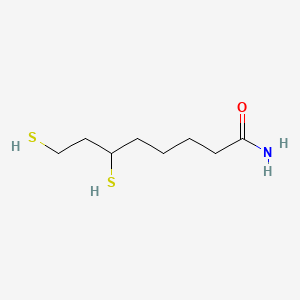| MeSH term | MeSH ID | Detail |
|---|---|---|
| Parkinsonian Disorders | D020734 | 20 associated lipids |
Dihydrolipoamide
Dihydrolipoamide is a lipid of Fatty Acyls (FA) class. Dihydrolipoamide is associated with abnormalities such as Wiskott-Aldrich Syndrome. The involved functions are known as Citric Acid Cycle, Electron Transport, NADH oxidation, Oxidation and Oxidants. Dihydrolipoamide often locates in Mitochondria, Mitochondrial matrix and Chloroplasts. The associated genes with Dihydrolipoamide are Mutant Proteins, Recombinant Proteins, mycothione reductase, Genes, Mitochondrial and alanylproline.
Cross Reference
Introduction
To understand associated biological information of Dihydrolipoamide, we collected biological information of abnormalities, associated pathways, cellular/molecular locations, biological functions, related genes/proteins, lipids and common seen animal/experimental models with organized paragraphs from literatures.
What diseases are associated with Dihydrolipoamide?
Dihydrolipoamide is suspected in and other diseases in descending order of the highest number of associated sentences.
Related references are mostly published in these journals:
| Disease | Cross reference | Weighted score | Related literature |
|---|
Possible diseases from mapped MeSH terms on references
We collected disease MeSH terms mapped to the references associated with Dihydrolipoamide
PubChem Associated disorders and diseases
What pathways are associated with Dihydrolipoamide
There are no associated biomedical information in the current reference collection.
PubChem Biomolecular Interactions and Pathways
Link to PubChem Biomolecular Interactions and PathwaysWhat cellular locations are associated with Dihydrolipoamide?
Visualization in cellular structure
Associated locations are in red color. Not associated locations are in black.
Related references are published most in these journals:
| Location | Cross reference | Weighted score | Related literatures |
|---|
What functions are associated with Dihydrolipoamide?
Related references are published most in these journals:
| Function | Cross reference | Weighted score | Related literatures |
|---|
What lipids are associated with Dihydrolipoamide?
There are no associated biomedical information in the current reference collection.
What genes are associated with Dihydrolipoamide?
Related references are published most in these journals:
| Gene | Cross reference | Weighted score | Related literatures |
|---|
What common seen animal models are associated with Dihydrolipoamide?
There are no associated biomedical information in the current reference collection.
NCBI Entrez Crosslinks
All references with Dihydrolipoamide
Download all related citations| Authors | Title | Published | Journal | PubMed Link |
|---|---|---|---|---|
| Takahashi T et al. | NADPH-dependent coenzyme Q reductase is the main enzyme responsible for the reduction of non-mitochondrial CoQ in cells. | 2008 | Biofactors | pmid:19096101 |
| Gómez-Baena G et al. | Glucose uptake and its effect on gene expression in prochlorococcus. | 2008 | PLoS ONE | pmid:18941506 |
| Min CK et al. | Genome-based construction of the metabolic pathways of Orientia tsutsugamushi and comparative analysis within the Rickettsiales order. | 2008 | Comp. Funct. Genomics | pmid:18528528 |
| Vasquez-Robinet C et al. | Physiological and molecular adaptations to drought in Andean potato genotypes. | 2008 | J. Exp. Bot. | pmid:18535297 |
| Jaleel A et al. | In vivo measurement of synthesis rate of individual skeletal muscle mitochondrial proteins. | 2008 | Am. J. Physiol. Endocrinol. Metab. | pmid:18765679 |
| Norton GJ et al. | Rice-arsenate interactions in hydroponics: whole genome transcriptional analysis. | 2008 | J. Exp. Bot. | pmid:18453530 |
| Yang L et al. | BMDExpress: a software tool for the benchmark dose analyses of genomic data. | 2007 | BMC Genomics | pmid:17961223 |
| Brown SE et al. | Targeting lipoic acid to mitochondria: synthesis and characterization of a triphenylphosphonium-conjugated alpha-lipoyl derivative. | 2007 | Free Radic. Biol. Med. | pmid:17512456 |
| Yan LJ et al. | Histochemical staining and quantification of dihydrolipoamide dehydrogenase diaphorase activity using blue native PAGE. | 2007 | Electrophoresis | pmid:17315258 |
| Alvaro D et al. | Genome-wide analysis of Rad52 foci reveals diverse mechanisms impacting recombination. | 2007 | PLoS Genet. | pmid:18085829 |
| Jackson AP | Evolutionary consequences of a large duplication event in Trypanosoma brucei: chromosomes 4 and 8 are partial duplicons. | 2007 | BMC Genomics | pmid:18036214 |
| Coker JA and DasSarma S | Genetic and transcriptomic analysis of transcription factor genes in the model halophilic Archaeon: coordinate action of TbpD and TfbA. | 2007 | BMC Genet. | pmid:17892563 |
| Marques B et al. | Liposome-mediated cellular delivery of active gp91(phox). | 2007 | PLoS ONE | pmid:17848987 |
| Heinicke S et al. | The Princeton Protein Orthology Database (P-POD): a comparative genomics analysis tool for biologists. | 2007 | PLoS ONE | pmid:17712414 |
| LuÃs PB et al. | Valproic acid metabolites inhibit dihydrolipoyl dehydrogenase activity leading to impaired 2-oxoglutarate-driven oxidative phosphorylation. | 2007 | Biochim. Biophys. Acta | pmid:17706936 |
| Liberti EA et al. | Effects of combined pre- and post-natal protein deprivation on the myenteric plexus of the esophagus of weanling rats: a histochemical, quantitative and ultrastructural study. | 2007 | World J. Gastroenterol. | pmid:17659710 |
| Pino P et al. | Dual targeting of antioxidant and metabolic enzymes to the mitochondrion and the apicoplast of Toxoplasma gondii. | 2007 | PLoS Pathog. | pmid:17784785 |
| Günther S et al. | Apicoplast lipoic acid protein ligase B is not essential for Plasmodium falciparum. | 2007 | PLoS Pathog. | pmid:18069893 |
| HÃ¥kansson AP and Smith AW | Enzymatic characterization of dihydrolipoamide dehydrogenase from Streptococcus pneumoniae harboring its own substrate. | 2007 | J. Biol. Chem. | pmid:17690105 |
| Ojha S et al. | Evolution of function in the "two dinucleotide binding domains" flavoproteins. | 2007 | PLoS Comput. Biol. | pmid:17658942 |
